Posted May 20, 2018 by Nicky in Reviews / 0 Comments
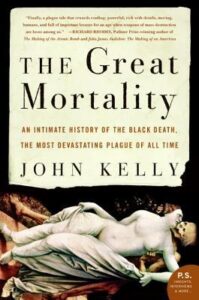 The Great Mortality, John Kelly
The Great Mortality, John Kelly
The Great Mortality is how the Black Death was referred to, before we came to know it by that evocative name. There’s a lot of detail here if you’re interested in the historical aspects of the plague: where it struck, how people reacted, the changes it brought about. The scientific background is a bit more lacking, though: there’s some tantalising hints, like a brief discussion of the increased virulence of the illness compared to the modern version that’s still endemic in some parts of the world, but for me with my primarily scientific rather than purely historical or sociological outlook, it began to drag.
So, not a bad read, but not what I was really looking for.
Rating: 3/5
Tags: book reviews, books, history, non-fiction, science
Posted May 15, 2018 by Nicky in Reviews / 2 Comments
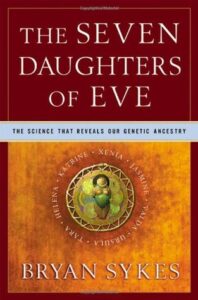 Seven Daughters of Eve, Bryan Sykes
Seven Daughters of Eve, Bryan Sykes
It’s been a while since this book was published, of course, and the science of investigating ancient mitochondrial DNA has been going from strength to strength, but this is still a good book on the background of that research, the importance of mitochondrial DNA, and the idea that we can trace our lineage back through the female line to just a few specific women. (Actually, this is very Europe-centric, a fact that becomes clear when you read the whole book: the seven ‘clan mothers’ mentioned are only the last common ancestors of European mitochondrial lines.)
Sykes writes clearly and well, and the only bit I wasn’t happy with as popular science writing is the little fake histories of the seven women. He tries to put flesh on the bones of what the women might have been like, the environment and social situations they would have encountered, but it’s really far too much like pure fiction for me. If he’d even included some more perhapses and maybes and alternative scenarios, I might have been more comfortable with it. As it is, it gives us a false idea that there were seven such knowable women.
Still, it’s fascinating stuff and I do love reading about this kind of genetic detective work.
Rating: 4/5
Tags: book reviews, books, non-fiction, science
Posted May 13, 2018 by Nicky in Reviews / 0 Comments
 Universal, Brian Cox, Jeff Forshaw
Universal, Brian Cox, Jeff Forshaw
This is really clearly written, it covers fascinating subjects, and the authors have tried really hard to equip readers with the ability to think things through for themselves. They don’t just state conclusions: they lead the reader through how those conclusions were reached, until they are also inevitable for the reader. It’s a smart way to write, although the right people — the people who look at the conclusions and decide they’re wrong without any evidence — probably won’t actually go through the evidence.
Unfortunately, a lot of this evidence involves thinking mathematically, which is not a strong point for me. I can hammer something into my head for practical purposes (I can now do a bunch of statistical tests using paper and a calculator!) and I can remember how to calculate something I find interesting (the number of base pairs in a fragment of DNA from how far it travelled during gel electrophoresis), but I’m not good with big concepts. And Cox and Forshaw tackle some of the biggest here.
At another time, I might be in the mood to work through this more thoroughly. As it is, I didn’t finish it — not because I think it’s bad (it’s not), but just because this is not the time. Too much for me to learn that’s more immediately relevant.
(Remember that my ratings denote enjoyment, not usefulness or interestingness per se. It’s just… maths. Not for me, not right now.)
Rating: 2/5
Tags: book reviews, books, non-fiction, science
Posted April 26, 2018 by Nicky in Reviews / 0 Comments
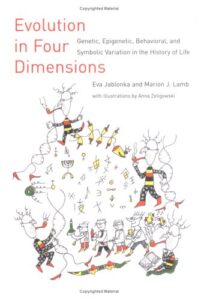 Evolution in Four Dimensions, Eva Jablonka, Marion J. Lamb
Evolution in Four Dimensions, Eva Jablonka, Marion J. Lamb
This is really clear if you know a bit about what it’s talking about, and probably impossibly dense if you don’t. The illustrations are rather whimsical usually, rather than being useful (even for people who aren’t me and can make sense of things they’re looking at!), and there are “dialogues” at the end of each chapter which go over the previous points and basically play a bit of Devil’s advocate. They didn’t work for me because it was so artificial — obviously they wrote the dialogues entirely themselves, so it was just the questions they wanted to answer — but it might be helpful in clarifying some things for some readers.
There’s some new stuff since this revised edition came out, but it’s still a good primer on epigenetics and some of the other things that are significant when you discuss evolution (like culture). I probably wouldn’t recommend it to a layperson, but if you’re already interested, it’s a good one.
Rating: 4/5
Tags: book reviews, books, non-fiction, science
Posted April 22, 2018 by Nicky in Reviews / 0 Comments
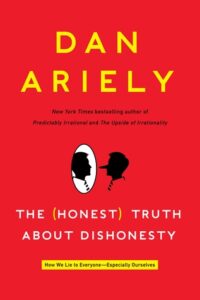 The (Honest) Truth About Dishonesty, Dan Ariely
The (Honest) Truth About Dishonesty, Dan Ariely
The reasons why we lie and to what extent we’re willing to lie are pretty fascinating, and if you haven’t read anything else of the sort before, this might be pretty revelatory. Ariely explains the various studies and results pretty clearly, and it’s definitely not aimed at people who have actually dug into the academic publications: it’s accessible to a layperson, definitely, and to my mind pretty much aimed at the layperson. At any rate, I didn’t find any of it surprising, because I’ve read most of this before and know something of the way we’ve discovered our brains work. I’m not 100% positive there was nothing new, but there wasn’t much that didn’t sound familiar.
So, a good read if you’re looking for something on the subject, but probably not much point if you’re already pretty aware of research into dishonesty and why we lie.
Rating: 3/5
Tags: book reviews, books, non-fiction, science
Posted April 6, 2018 by Nicky in Reviews / 4 Comments
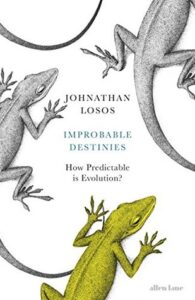 Improbable Destinies, Jonathan Losos
Improbable Destinies, Jonathan Losos
The question Losos asks, and tries to answer, is this: can we predict evolution? Are certain things inevitable in development — birds, humans, antibiotic resistance, etc, etc? He writes engagingly about field work, experiments, thought experiments, the various theories and people who have supported them… I definitely want to do more reading on this.
Am I convinced? Well, I’m not sure Losos is convinced that evolution can be predicted in detail; he presents some good evidence that suggests that you can predict the sorts of changes in gene function that will be beneficial in a certain environment, but that you can’t predict exactly how those changes will come about. Sometimes one gene might be altered, sometimes another. The phenotype is predictable (unsurprisingly: look for what would benefit the species in breeding successfully) but the genotype is not, unless it’s a fairly simple case of one particular molecular switch needing to be flipped on or off. There is a great deal of contingency in the process of evolution: Gould was (at least to some extent) correct in suggesting that we can’t “rewind the tape of life” and then see things proceed in exactly the same way.
As with determinism in any sense, I generally believe that if all factors were known, we would also know the result. I’m just not sure we can know those factors (and I dislike and squirm away from applying it to human ethics — our actions may be caused by previous events, but we don’t experience the process that way, so it’s irrelevant in how to be moral) — especially given events on a quantum level.
Rating: /5
Tags: book reviews, books, non-fiction, science
Posted April 5, 2018 by Nicky in Reviews / 0 Comments
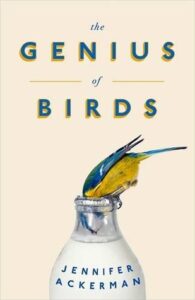 The Genius of Birds, Jennifer Ackerman
The Genius of Birds, Jennifer Ackerman
If you’ve read much about animal intelligence, most of the stuff in this book won’t be all that surprising, though of course since it’s entirely about birds, it includes a lot more anecdotes and bird-focused studies. As a whole, the book definitely makes a case for birds as specialised, well adapted, and very intelligent in their own spheres. We won’t be having philosophical discussions with them any time soon, though, if that’s what you thought ‘genius’ meant. And I think honestly that Ackerman makes less of a case for bower birds’ displays being art than others I’ve read.
It’s an easy read, and good for some ‘huh, cool’ moments, but not the most rigorous or unmissable popular science book out there.
Rating: 3/5
Tags: book reviews, books, non-fiction, science
Posted March 26, 2018 by Nicky in Reviews / 0 Comments
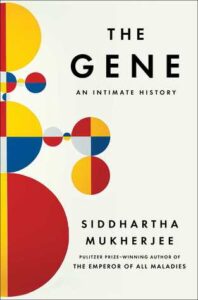 The Gene: An Intimate History, Siddhartha Mukherjee
The Gene: An Intimate History, Siddhartha Mukherjee
The Gene isn’t quite as great as The Emperor of All Maladies: the fact that this isn’t as much Mukherjee’s forte definitely shows, and there’s a couple of points of fact I’d quibble about. For the most part, though, it’s a really great discussion of genetics and the way they actually affect people, tracing a history of mental illness in Mukherjee’s own family as an example. I know this field pretty darn well by this point, and this is far from the first book I’ve read about genetics, but Mukherjee is a good writer, making it all seem fresh and worth reading even when it’s stuff I know backwards and forwards, and probably inside out too.
If you’re curious about genetics, about what genetics can do for us, and about how exactly things like recessive genes and pleiotropy work, this is a good choice. It’s not for experts, but it’s still a pleasant read even if you do know the topic already.
Rating: 4/5
Tags: book reviews, books, non-fiction, science
Posted March 20, 2018 by Nicky in Reviews / 0 Comments
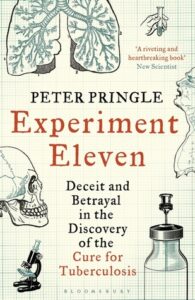 Experiment Eleven, Peter Pringle
Experiment Eleven, Peter Pringle
I initially picked this up because of the subtitle, which specifically mentions the discovery of a cure for tuberculosis. In fact, for the most part it isn’t about the science, but more about the intellectual property battle that surrounded the discovery of streptomycin. It’s more about the two main scientists it discusses, and their struggle over who really found streptomycin. The way the book tells it, I think it’s clear that Waksman was wrong to claim all the credit, and knew he was; Schatz should have received much more credit and recognition for what he did.
It’s interesting in the sense of illuminating what goes on to get drugs from the lab bench to actual development, where Waksman really did play a key role. It might be a bit wearing if you’re not that interested in what’s essentially a biography of the two scientists, though.
Rating: 3/5
Tags: book reviews, books, non-fiction, science
Posted March 15, 2018 by Nicky in Reviews / 2 Comments
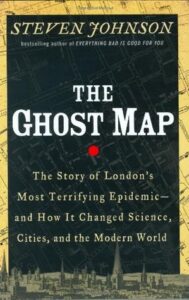 The Ghost Map, Steven Johnson
The Ghost Map, Steven Johnson
This is a really good account of the outbreak of cholera that led to John Snow’s famous map, showing that a particular water pump was the culprit. He traces the history of how London dealt with sewage and how it became such a big issue, and also examines some of the main characters in the drama of trying to stop the outbreak — and trying to challenge miasma theory, which was so much the paradigm at the time. There isn’t a lot of specific science stuff here, but Johnson makes clear why the cholera pathogen is so deadly in a very accessible way.
The only weird part is in the conclusion/afterword to the book, where Johnson talks more generally about the risks to city life and starts discussing nuclear war and terrorism. It seems very much a non-sequitur, and adds nothing to the book to my mind.
Rating: 4/5
Tags: book reviews, books, history, non-fiction, science
 The Great Mortality, John Kelly
The Great Mortality, John Kelly








